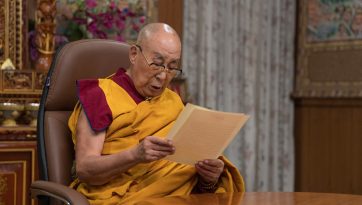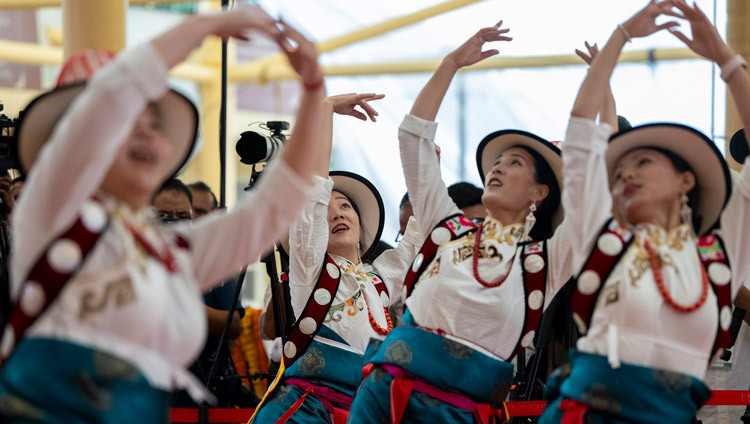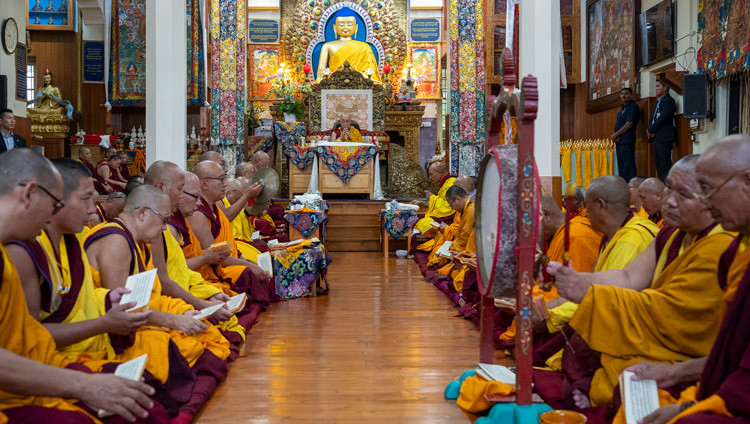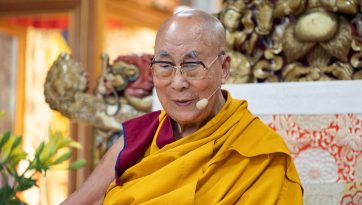Meeting with Participants in Tibet House’s Nalanda Courses
Thekchen Chöling, Dharamsala, HP, India – This morning, despite the continuing unseasonable cold and wet weather, His Holiness the Dalai Lama met with almost 500 students who have recently graduated from or are currently studying in the Nalanda Masters Course, the Nalanda Diploma Course or the Nalanda Diploma course offered by Tibet House, New Delhi. At present there are more than 4000 students from 98 countries enrolled in courses run by Geshé Dorji Damdul from Tibet House.
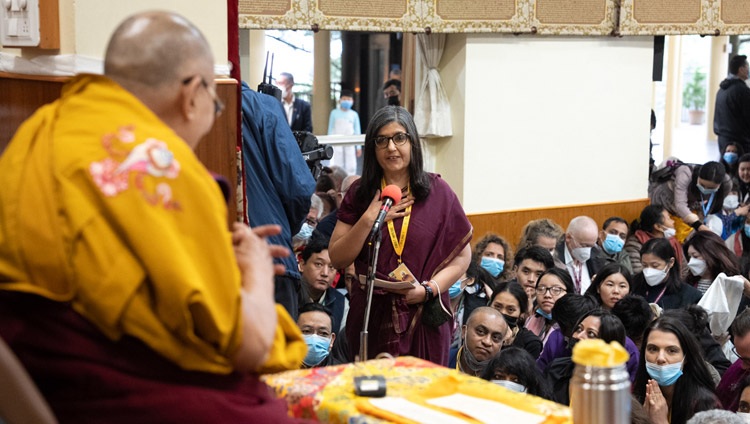
Dr Kaveri Gill introducing the program with His Holiness the Dalai Lama and participants in Tibet House’s Nalanda Courses at the Main Tibetan Temple in Dharamsala, HP, India on June 2, 2023. Photo by Tenzin Choejor
Dr Kaveri Gill introduced the students and staff of Tibet House to His Holiness and thanked him for sending them a teacher of such calibre as Geshé Dorji Damdul.
Geshé Dorji Damdul then offered three statues and a framed poster related to the Nalanda Courses to His Holiness. He expressed heartfelt respects to His Holiness, to the Sikyong, Penpa Tsering, and to Vice Chairperson of Tibet House, and former Indian Foreign Secretary, Dr Nirupama Rao.
“All of us are your students,” he told His Holiness. “We seek to learn from you. In the last century Mahatma Gandhi was the champion of non-violence—‘ahimsa’, but in the present century His Holiness, is the champion of compassion—‘karuna’.”
He paid tribute to everyone who has helped create the programmes at Tibet House and mentioned Tempa Tsering, Jetsun Pema and Doboom Rinpoché in particular. He also acknowledged that nothing would have taken place without the generous support of the Government of India’s Ministry of Culture and expressed gratitude.
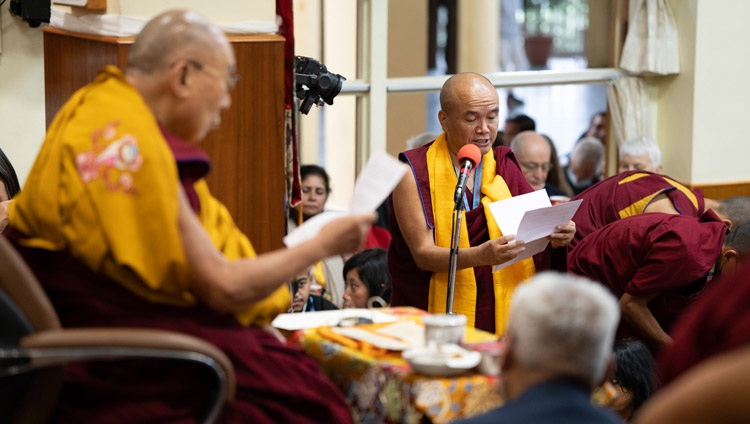
Geshé Dorji Damdul, director of Tibet House and primary teacher of the Nalanda courses, speaking at the meeting with His Holiness the Dalai Lama and participants in Tibet House’s Nalanda Courses at the Main Tibetan Temple in Dharamsala, HP, India on June 2, 2023. Photo by Tenzin Choejor
“We are trying to carry forward the torch of compassion and wisdom that His Holiness has held high by promoting fundamental human values. With the help of Telo Tulku we have also recently extended activities related to the Nalanda Courses to Russian-speaking people.
“It is to our hope that universal ethics will be adopted by the United Nations. We pray that world leaders may learn from His Holiness as we aim to achieve peace, freedom and security. May the world continue to enjoy the sunlight of your leadership.”
Mr Deepesh Thakkar, Chief Coordinator of the Nalanda Courses, saluted the chief guests and explained that Tibet House had set up long, medium and short courses of six years, 14 months and one and a half months respectively, to suit their students’ needs. The first group to complete the Nalanda Masters’ six-year course have recently graduated.
Thakkar remarked that Geshé Dorji Damdul had been a guiding light. He noted that among the students there are twice as many women as men and the students’ ages range from 14 to 80 years old.
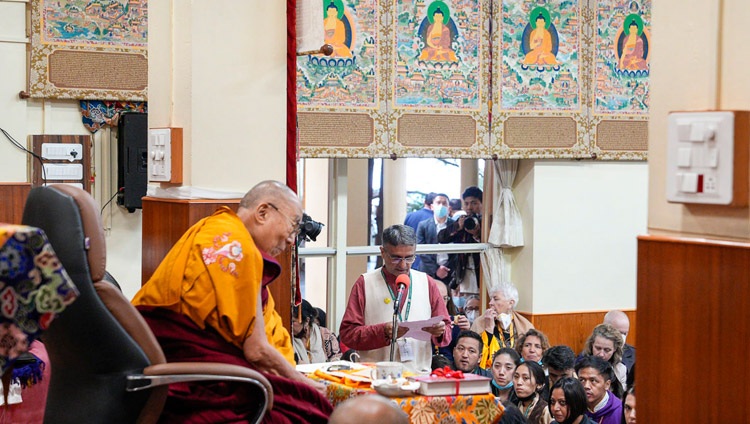
Mr Deepesh Thakkar, Chief Coordinator of the Nalanda Courses, speaking at the the meeting with His Holiness the Dalai Lama and participants in Tibet House’s Nalanda Courses at the Main Tibetan Temple in Dharamsala, HP, India on June 2, 2023. Photo by Ven Tenzin Jamphel
“We aim,” he asserted, “not to propagate Buddhism but to share the knowledge it vouchsafes to help as many people as possible to be happier, kinder human beings. We thank His Holiness from the bottom of our hearts and also express gratitude to the Tibetan people dedicated down the centuries to preserving the Nalanda Tradition. We pray that His Holiness live long and request that we may continue to receive teachings from him.”
His Holiness addressed the audience, smiling. “Good morning my Dharma brothers and sisters. It’s good that we have this opportunity to meet. Thank you to everyone who has worked to organize it. Having been in exile so long I’ve met so many different people on occasions like this and we have learned from each other.
“Regarding the teaching of the Buddha, Jé Tsongkhapa wrote at the end of his ‘Great Treatise on the Stages to the Path to Enlightenment’:
“Wherever the Buddha’s teaching has not spread
And wherever it has spread but has declined
May I, moved by great compassion, clearly elucidate
This treasury of excellent benefit and happiness for all.
“Places where Buddhism has not spread include Europe and so forth. In the past, people living in those countries only paid attention to their own religious traditions, but these days many are taking an interest in other traditions, particularly the spiritual traditions of India.
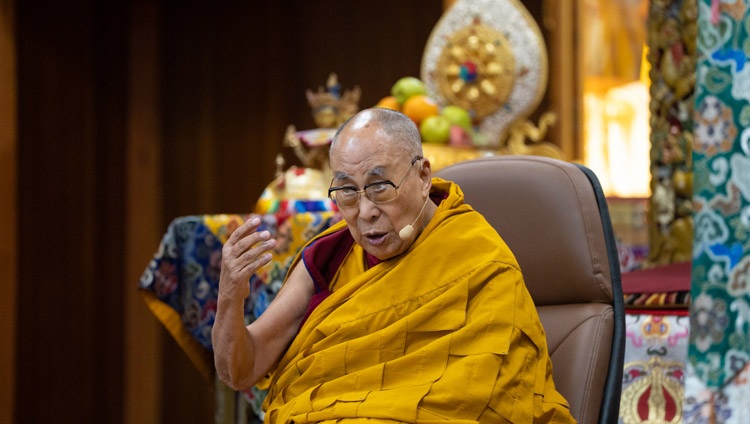
His Holiness the Dalai Lama addressing the audience during the meeting with participants in Tibet House’s Nalanda Courses at the Main Tibetan Temple in Dharamsala, HP, India on June 2, 2023. Photo by Tenzin Choejor
“The essence of the Nalanda Tradition is not ritual and prayer but being able to transform the mind. We set up Tibet House so people could learn more about it. Tibet was not always Buddhist, but became so in the 7th and 8th centuries when our kings took an interest. King Songtsen Gampo commissioned a new Tibetan script modelled on the Devanagari alphabet. Consequently, when Shantarakshita came to the Land of Snow at the invitation of King Trisong Detsen, he was able to recommend that Indian Buddhist literature be translated into Tibetan. The result is the Kangyur and Tengyur collections.
“King Trisong Detsen also organized a debate between Kamalashila, who was Shantarakshita’s student, and representatives of the Hvashang Chinese monks. He judged that Kamalashila was able to provide extensive explanations of what the Buddha taught, whereas the Chinese monks were largely focussed on meditation.
“Shantarakshita and Kamalashila established an approach to study and training that involved developing understanding by reading and listening, deepening that understanding through reflection, using reason and logic, and acquiring experience of it in meditation.
“In due course, the great monasteries of Sera, Ganden, Drepung and Tashi Lhunpo became centres of learning where monks studied the great treatises and then used logic to explore what they had learned in debate. Buddhism flourishes in several countries today, but only Tibetan Buddhism presents a comprehensive explanation of what the Buddha taught. Moreover, when scientists want to learn more about what Buddhism has to say about the workings of the mind, they take an interest in the Tibetan tradition.
“It’s because we rely on reason and logic that we have been able to contribute something to the welfare of the world in the context of secular ethics.”
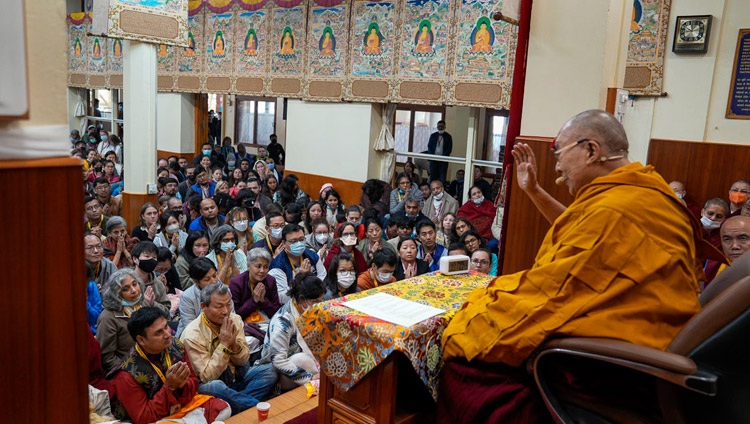
His Holiness the Dalai Lama speaking at the meeting with participants in Tibet House’s Nalanda Courses at the Main Tibetan Temple in Dharamsala, HP, India on June 2, 2023. Photo by Ven Tenzin Jamphel
His Holiness mentioned how keen he is to encourage inter-religious harmony. He acknowledged that different spiritual traditions may adopt quite different philosophical positions, but what they all have in common is an emphasis on cultivating a good heart. He noted that India is an exemplary nation where all the world’s major religious traditions flourish side by side. He reiterated what had already been said about the Nalanda Courses being much less about people becoming Buddhist and much more about their being able to enrich their own practice and faith with what they are able to learn from the Nalanda Tradition.
Although Tibet House representatives had requested that His Holiness give an oral transmission of Jé Tsongkhapa’s ‘Three Principal Aspects of the Path’, he announced that on this occasion he would prefer to give the transmission of Jé Rinpoché’s ‘In Praise of Dependent Arising’. He quoted a verse towards the end of this work in which Tsongkhapa expresses his intention:
Becoming ordained in the way of the Buddha
by not being lax in study of his words,
and by yoga practice of great resolve,
this monk devotes himself to that great purveyor of truth. 53
His Holiness revealed that he too feels great gratitude and devotion to the Buddha because it is by relying on his teaching that he has been able to cultivate the aspiring mind of bodhichitta and an understanding of emptiness.
“Even as a child,” he added, “I had a propensity not to simply accept what I was told. I felt a need to question and investigate it. As someone with the name Dalai Lama I can’t make use of conventional weapons, but I can argue. And I can use my intelligence to investigate the teaching of the Buddha and explain it to others. Questioning and investigating are at the heart of the Nalanda Tradition.
“I received the transmission and explanation of ‘In Praise of Dependent Arising’ from the Khunu Lama Rigzin Tenpa.
“Dependent arising defines the Buddha’s teaching,” His Holiness declared. “Of the two syllables of the Tibetan term for this, ‘ten-jung’, the first means dependent and the second, arising. This gives us an insight into reality. Everything is dependent. Nothing is independent. Things arise in dependence on other factors. Since nothing is independent, everything comes about through dependent relationships.”
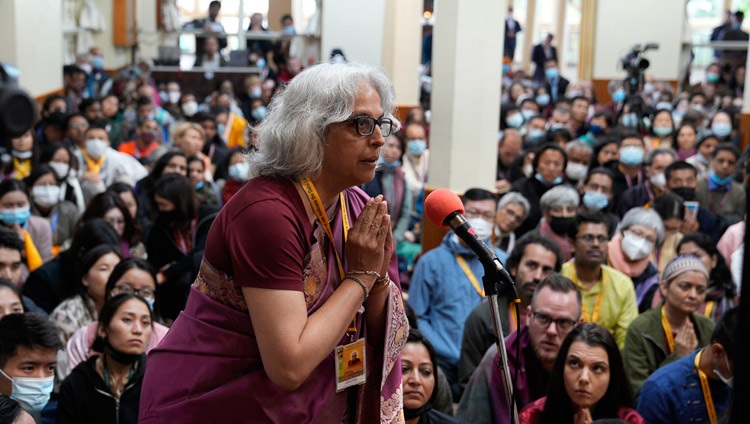
A member of the audience asking His Holiness the Dalai Lama a question during the meeting with participants in Tibet House’s Nalanda Courses at the Main Tibetan Temple in Dharamsala, HP, India on June 2, 2023. Photo by Ven Tenzin Jamphel
His Holiness drew attention to two early verses that praise the Buddha:
This teaching is not seen in the works of others,
the title of Teacher, therefore, is yours alone.
Given to others it is but the hollow flattery
of a fox being hailed as a lion. 7
Greatest of teachers! Greatest protector!
Speaker supreme!
Guide supreme!
I bow to the teacher of dependent arising! 8
“We are all followers of Buddha Shakyamuni,” he proclaimed, “and the best way to repay his kindness is to cultivate the altruistic mind of bodhichitta and an understanding of emptiness. This is what I do, and because of these practices I feel at ease.”
His Holiness answered several questions from the audience, who were then gathered in groups to have their photographs taken with him.

